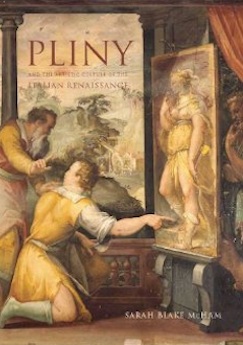By Lewis Fried
This praiseworthy study, ripe in implications for our own day, is meticulous and extensive, dealing with Pliny’s presence in, and influence upon Italian Renaissance “artists, patrons, and theorists.” Happily, the book also deals with the broad area of letters. Among McHam’s topics, all done with scholarly thoroughness and authority, are chapters such as “The Art History of a Book on Science,” “The Natural History in the Age of Incunables,” and invaluable discussion entitled “Pliny’s Legacy.”
Pliny’s Natural History is so vast a summation, and so categorical a series of topics that it comes as no surprise that the work is often considered to be the assessment of the heritage of late first-century arts and sciences by one of Rome’s remarkable citizens and writers. Arts and sciences, though, is too narrow a term, for in his “Preface,” a letter to the Emperor Titus, Pliny termed his Natural History a “novel venture for the Muses who inspire your Roman citizens.” His subject , he wrote, is the “natural world, or life (that is life in its most basic aspects).” Noting the exhaustiveness of his research, Pliny informed the reader that the “thirty-seven books” of the Natural History were nourished by his reading “2,000 volumes” and bringing to attention “some 20,000 facts worthy of note from 100 authors whom I have researched.” Moreover, Pliny added “facts that my predecessors did not know or that I have subsequently discovered from my own personal experience.”
The energy expended on printing, translating, illustrating, and correcting copies of Pliny’s Natural History testifies to its extraordinary importance: it provided a “vocabulary of first-century technical and scientific terms”; it dwelt upon parts of a classical heritage that had disappeared; Pliny’s praise of patrons, artists and their “signal inventions” nourished “constructive competitiveness; the Natural History‘s judgments and methods influenced Renaissance art theory, history, and focus; his aesthetic preference for realism encouraged a dedication to how people and things actually looked, and the Natural History became a work used by others in compiling narrower encyclopedias. Given all of this, there was not one Pliny but many, found in the circulation of condensations as well as excerpts of the work. (McHam notes that information a writer may have thought to come from Pliny may have actually derived from an “intermediary.”)
McHam makes clear that Pliny was a fortunate observer; his Rome was the center of empire and repository of imperial culture. Within the city, Pliny had access to the fullness of the Roman empire’s reach: from artists to civic architecture to sculpture to painting, and to workshops themselves. As a result, the Natural History functioned as the indispensable reference work—given the ruins of war and attritions of material—of Greece and Rome: consulted, at first, for its account of Nature and civilization, and historically later to comprehend what a Roman thought about the cultures one inherited and interpreted.
McHam brings to our attention Pliny’s claim that the Natural History also served as an intellectual demonstration of civic worthiness. The Natural History ends—at least my edition does—with Pliny’s praise of Italy: that country is “the ruler and second mother of the world.” And, Pliny’s encomium on Nature, he writes, distinguishes him, “for I alone of Rome’s citizens have praised you in all your aspects.” The author extends the import of Pliny as a civic writer; its message about the city (read: our cities) is a call to stimulate and conserve cultural activity, making for the encultured community and its values.
At first glance, and only at first glance, the Natural History seems to be a “baggy” work. It appears to be a loosely sewn-together series of compendia, interspersed with anecdotes, personal judgments, and commentaries that make it easy to miss some of Pliny’s rhetorical strategies. Nevertheless, Natural History does have a strong architecture (ranging from Nature to nature to uses of nature, to human creativity in architecture to the nature’s workable attractions, such as gemstones). It also relies on formal devices to keep the material in order as well as to illuminate it. McHam’s study shines in these matters, large and small.
To take one example: McHam points out that the Plinian anecdote was used to convince the reader of an argument’s correctness, and in some instances, as a way to “underscore the larger category (synecdoche) as the most outstanding example of a category, and as a link in a chain of narrative units.” Such anecdotes were “ample inspiration” for Renaissance artists. They also demonstrated the cooperative nature between patron and artist (such as Alexander and Apelles) and the struggle for excellence amongst artists. Notable is Pliny’s account of the rivalry between Parrhasius and Zeuxis: which one painted so realistically that in one case, birds were fooled by pecking at painted grapes, yet which one painted even more realistically that he fooled the other into believing that a painted curtain had to be drawn aside?
As usual, Yale has produced a book that is handsome, even handsome to excess. Its plates, its typography and format complement well McHam’s research. This is a book worth reading and having.
Lewis Fried (ΦBK, Queen’s College, CUNY, 1964) is Professor of English Emeritus at Kent State University and a resident member of the Nu of Ohio chapter of Phi Beta Kappa.




